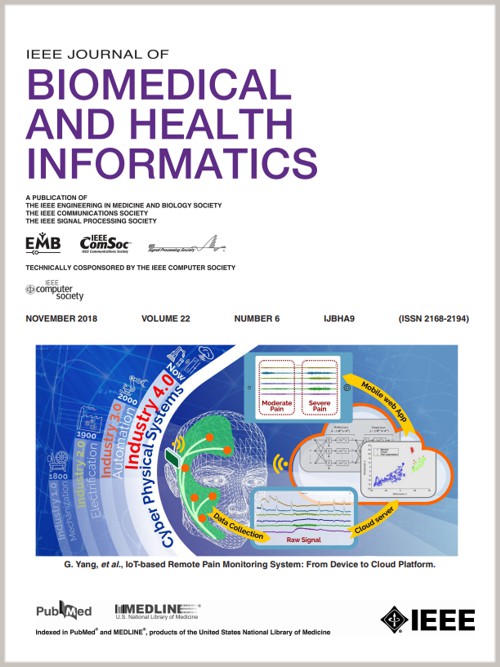经皮耳廓迷走神经刺激调节脑岛-内侧前额叶皮层功能连接:fMRI研究。
IF 6.7
2区 医学
Q1 COMPUTER SCIENCE, INFORMATION SYSTEMS
IEEE Journal of Biomedical and Health Informatics
Pub Date : 2024-07-04
DOI:10.1109/JBHI.2024.3423019
引用次数: 0
摘要
经皮耳廓迷走神经刺激(taVNS)是一种新兴的神经调控技术,多项研究表明它对治疗疾病有益,但其确切的作用机制仍不清楚。研究表明,ta VNS 可以影响感觉间信号。值得注意的是,感受间信号的处理与许多疾病直接相关,如抑郁症、焦虑症和失眠症。脑岛和内侧前额叶皮层(MPFC)在ta VNS 诱导的信号自下而上的传输过程中进行交流,两者都在感知间信号处理中发挥作用。通过聚焦脑岛和内侧前额叶皮层,我们的研究开创性地详细阐述了感知间信号处理与 taVNS 神经调节效应之间的潜在相互作用,为 taVNS 的神经生物学机制提供了新的见解。本研究采用了两种功能连接(FC)分析(基于兴趣区域和基于种子)。我们观察到,在进行 taVNS 后,脑岛和大脑中枢皮层之间的负连接性明显减弱,而假性组则无统计学变化。我们的研究结果阐明了迷走神经活动与特定脑区和网络间内在功能连接的潜在机制。具体来说,我们的研究结果表明,taVNS 可通过调节岛叶和大脑中枢皮层(MPFC)之间的 FC 来增强灵活平衡感知间意识和认知体验的能力。这种调节作用可能会影响身体与大脑之间的相互作用,从而提出了 taVNS 在治疗方面的应用机制。本文章由计算机程序翻译,如有差异,请以英文原文为准。
Insula-Medial Prefrontal Cortex Functional Connectivity Modulated by Transcutaneous Auricular Vagus Nerve Stimulation: An fMRI Study
Transcutaneous auricular vagus nerve stimulation (taVNS) is an emerging neuromodulation technology that has been reported to be beneficial in the treatment of diseases by several studies, but its exact mechanism of action is still unclear. It has been demonstrated that taVNS can influence interoceptive signals. Notably, the processing of interoceptive signals is directly related to many diseases, such as depression, anxiety, and insomnia. The insula and the medial prefrontal cortex (MPFC) communicate during the bottom-up transmission of taVNS-induced signals, and both play a role in interoceptive signal processing. By focusing on the insula and MPFC, our research pioneers detail the potential interactions between interoceptive signal processing and the neuromodulation effects of taVNS, providing novel insights into the neurobiological mechanisms of taVNS. Two functional connectivity (FC) analyses (region of interest-based and seed-based) were used in this study. We observed that negative connectivity between the insula and the MPFC was significantly weakened following taVNS, while there were no statistical changes in the sham group. Our findings elucidate potential mechanisms linking vagal activity with intrinsic FC among specific brain regions and networks. Specifically, our results indicate that taVNS may enhance the ability to flexibly balance interoceptive awareness and cognitive experiences by modulating the FC between the insula and MPFC. The modulation effects may impact body-brain interactions, suggesting the mechanism of taVNS in therapeutic applications.
求助全文
通过发布文献求助,成功后即可免费获取论文全文。
去求助
来源期刊

IEEE Journal of Biomedical and Health Informatics
COMPUTER SCIENCE, INFORMATION SYSTEMS-COMPUTER SCIENCE, INTERDISCIPLINARY APPLICATIONS
CiteScore
13.60
自引率
6.50%
发文量
1151
期刊介绍:
IEEE Journal of Biomedical and Health Informatics publishes original papers presenting recent advances where information and communication technologies intersect with health, healthcare, life sciences, and biomedicine. Topics include acquisition, transmission, storage, retrieval, management, and analysis of biomedical and health information. The journal covers applications of information technologies in healthcare, patient monitoring, preventive care, early disease diagnosis, therapy discovery, and personalized treatment protocols. It explores electronic medical and health records, clinical information systems, decision support systems, medical and biological imaging informatics, wearable systems, body area/sensor networks, and more. Integration-related topics like interoperability, evidence-based medicine, and secure patient data are also addressed.
 求助内容:
求助内容: 应助结果提醒方式:
应助结果提醒方式:


